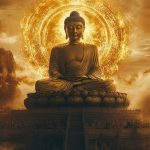Monk Hats: Symbols of Buddhist Tradition and Spiritual Path
Are 「monks’ hats」 simply practical head coverings, or do they carry a much richer story within Buddhist traditions? As we explore, these aren’t just pieces of cloth; 「Buddhist headwear」 items are intricate symbols.
They reveal diverse lineages, historical journeys, and deep spiritual meanings, giving us a clearer picture of their role in the monastic path. Despite their distinct forms and regional adaptations, the visible variety of 「monks’ hats」 across different traditions ultimately speaks to a universal message of devotion, wisdom, and the monastic journey. Every fold, color, and shape often quietly holds centuries of 「Buddhist philosophy」 and teaching.
Diverse Forms: A Global Panorama of Monks’ Headwear
The world of 「Buddhist hat」 styles is incredibly diverse. Each one uniquely reflects regional, sectarian, and historical influences.
From the towering ceremonial hats seen in the Himalayas to the simpler caps of East Asia, these headwear items are absolutely central to a monk’s identity.
「Tibetan Monk Hat」s: Layers of Tradition
Tibetan Buddhism, in particular, presents an extraordinary array of 「Tibetan hats」. Each one comes laden with specific meanings.
You can often identify major sects by the color of their 「Tibetan monk hat」s. For example, Gelug monks typically wear yellow hats, while Nyingma monks are known for their red hats. Kagyu monks, especially in summer, might wear white or black caps.
Among the prominent styles is the Pandit Hat. It’s known for its round shape, upward taper, and long lappets that cover the ears.
This ancient style, thought to have originated in India, signifies an advanced level of education. You’ll often see it among scholarly monks in various traditions, including Sakya, Shangpa, Jonang, and Gelug.
The Lotus Hat is primarily associated with the Nyingma school. It’s often quite ornate and symbolizes wisdom, the purifying fire of enlightenment, and the blessings of Guru Padmasambhava.
These hats can feature rich symbolic elements. For instance, two layers might represent Vajrayana stages, three points could signify the Buddha’s three bodies, and five colors might stand for the five fruits.
Then there’s the distinctive Fan-shaped Hat, unique to Tibetan areas. It’s tall and wide, sometimes adorned with delicate pendants.
Its intricate design often represents the Western Paradise and the thousand Buddhas.
Another notable 「lama hat」 is the Black Hat of the Karmapas. This is a smaller, cap-style headwear from the Karma Kagyu tradition.
This hat carries a rich mythology. Some legends claim it was woven from the hair of dakinis and visible only to those with high spiritual realization. Later versions feature elaborate symbolism, including a double vajra, a crescent moon, the sun, and a jewel.
East Asian Simplicity and Discipline
In East Asian Buddhist traditions, especially Zen, headwear tends to be less elaborate than what you’d see in Tibet.
Monastics typically practice tonsure, which means shaving their heads. This acts as a powerful symbol of renouncing worldly fashion and esteem. Interestingly, while the historical Buddha is depicted without a hat, his head features an ushnisha, symbolizing expanded wisdom.
For Zen practitioners, the rakusu—a small, closed scarf worn around the neck—serves a symbolic purpose similar to a hat. It represents the precepts and formal initiation.
The samue, a simple, loose-fitting garment, functions as everyday workwear for Zen monks in Japan. It embodies mindfulness in daily tasks like cleaning or gardening.
Finally, the conical straw hat, known as kasa in Japan or dǒulì in China, is also a traditional 「Buddhist headwear」 for pilgrims and monks. It offers practical protection from the elements during their spiritual journeys.
Other Regional Adaptations
Beyond Tibet and East Asia, 「Buddhist monk hat」s continue to vary by region.
In some Southeast Asian countries, for example, conical hats primarily offer practical sun and rain protection for both monks and laypeople.
A different example is the bodhisattva Kṣitigarbha, widely revered in East Asian Buddhism. He’s often depicted as a monk with a shaved head, sometimes wearing a halo or a Five-Buddha crown that bears images of the Five Tathāgatas.
Woven Meanings: The Symbolism of Headwear
Each 「monks hat」 acts as a silent teacher, embodying layers of spiritual meaning through its design.
Its elements are never arbitrary; instead, they reflect deep philosophical and practical aspects of Buddhist life.
Colors, Shapes, and Spiritual Allegories
The colors of 「Tibetan monk hat」s are particularly significant.
Yellow, for instance, is often associated with wisdom, growth, compassion, and the accumulation of merit. Red symbolizes wisdom, the purifying fire of insight, and blessings.
These colors often connect back to specific monastic reforms or an emphasis on particular vows. Think of the Gelug tradition’s adoption of yellow hats, which signifies strict adherence to monastic rules.
The shapes of these hats also carry their own allegorical weight.
The towering forms of some ceremonial hats, for example, can represent the vastness of enlightened wisdom or the ascent of the spiritual path.
Even the meticulous construction of a 「Buddhist hat」 itself can be a meditative practice, infusing the object with deep intention.
Rank, Role, and Spiritual Journey
「Buddhist headwear」 often clearly denotes the wearer’s rank, role, and stage in their spiritual journey.
Only lineage holders, senior teachers, or qualified ritual specialists are permitted to wear certain ceremonial hats. These are believed to impart wisdom and blessings.
A 「lama hat」, for example, can indicate a monk’s academic achievement, their administrative position within a monastery, or their specific sectarian affiliation.
The Pandit Hat, as we saw, signifies an advanced level of education and is worn by scholars and abbots. Within a single tradition, like the Gelug monasteries, the variety of 「Tibetan hats」—such as the Drozma and Zolu fan-shaped hats—can even differentiate between deacon monks and general monks.
This visual hierarchy is crucial; it helps maintain order and respect within the monastic community.
Cultural Significance in Ritual and Daily Life
「Monks’ hats」 aren’t confined solely to the monastery walls. Their influence extends into the broader 「cultural significance of monk hats」, shaping rituals and even daily interactions.
They serve as powerful symbols, connecting the individual monk to a collective spiritual heritage.
Ceremonial Roles and Sacred Occasions
During important religious ceremonies, teachings, and official events, 「Buddhist monk hat」s become central to the visual and spiritual experience.
They subtly transform the wearer, marking them as a conduit for sacred traditions. The very act of donning a ceremonial 「Buddhist hat」 can be a ritual in itself, preparing the monk for deep engagement with the Dharma.
Imagine a 「Tibetan monk hat」 shimmering in the dim light of a temple, its intricate details catching your eye as a lama performs a sacred chant. This visual element truly deepens the spiritual atmosphere, gently guiding the gaze and mind of observers towards the sacred.

The Hat as a Personal and Collective Symbol
Beyond ceremony, a 「monks hat」 serves as both a personal symbol of a monk’s vows and a collective symbol of their tradition.
It visually communicates their commitment to the monastic path and their lineage. For many, it’s a constant reminder of their spiritual aspirations and the teachings they uphold.
The hat acts as a silent declaration, almost like a “walking scripture,” embodying the principles of devotion, discipline, and wisdom. It tells a story without words, speaking of the long lineage of masters and practitioners who have worn similar headwear before them.
Connection to 「Monk’s Robes」 and Attire
「Monks’ hats」 are an integral part of the broader monastic attire, beautifully complementing the traditional 「monk’s robes」.
Take the kasaya, for instance: often burgundy red and traditionally made from patched cloth, it symbolizes poverty and adherence to the Buddha’s original teachings.
The hat’s color and style are typically harmonious with the robes, creating a unified visual identity for the monastic order. This holistic approach to attire emphasizes simplicity and renunciation, ensuring that every element, from the 「Buddhist hat」 to the 「monk’s robes」, reinforces the wearer’s spiritual commitment.
Beyond the Fabric: Connecting to 「Buddhist Philosophy」
The true essence of 「monks’ hats」 extends far beyond their material form. It lies in their deep connection to 「Buddhist philosophy」.
They serve as tangible expressions of abstract concepts, guiding principles, and the very path to enlightenment.
Wisdom and Compassion: The Hat’s Silent Teaching
Many 「monks’ hats」 are imbued with symbolism representing wisdom (Prajna) and compassion (Karuna)—two fundamental pillars of 「Buddhist philosophy」.
The yellow color of Gelug hats, for example, explicitly represents the growth of wisdom and compassion. The intricate designs on 「lama hat」s can depict mandalas, sacred syllables, or symbols of enlightened beings, all serving as visual aids for meditation and contemplation.
These hats are like “unspoken sermons,” constantly reminding both the wearer and the observer of Buddhist practice’s ultimate goal: developing deep insight and boundless empathy for all sentient beings.
Headwear in 「Zen Practices」
While 「Zen practices」 often emphasize direct experience and stripping away external adornments, symbolic headwear still plays a subtle role, even here.
Individuals might adopt the concept of a “mindfulness hat” or “practice hat,” transforming a simple cap into a personal reminder to cultivate awareness throughout the day. This perfectly aligns with Zen’s emphasis on integrating mindfulness into every aspect of life, turning ordinary actions into opportunities for spiritual growth.
The very absence of elaborate headwear in many Zen contexts carries its own philosophical message: true enlightenment is an internal state, not dependent on external display. However, when headwear is used, it reinforces the disciplined and focused approach so characteristic of 「Zen practices」.
Ultimately, the humble 「monks’ hat」 is far more than just fabric. It’s a powerful artifact, a convergence of art, history, and deep spiritual meaning.
It invites us to look beyond the surface and truly appreciate the rich fabric of 「Buddhist philosophy」 and human devotion it represents.
So, returning to our initial question: are these hats merely practical items? Clearly not. These diverse 「Buddhist headwear」 items serve as silent guides, illuminating the varied paths to wisdom and compassion across the Buddhist world.
If you’re curious to delve deeper into the intricate world of Buddhist cultural artifacts, consider exploring other elements of monastic attire or the symbolism embedded in various Buddhist art forms.
💡 Häufig gestellte Fragen
The colors of Tibetan monk hats are highly significant. Yellow, for instance, is often associated with wisdom, growth, compassion, and the accumulation of merit. Red symbolizes wisdom, the purifying fire of insight, and blessings. These colors can also connect back to specific monastic reforms or an emphasis on particular vows within different traditions.
Buddhist headwear often clearly denotes the wearer's rank, role, and stage in their spiritual journey. Certain ceremonial hats are reserved for lineage holders, senior teachers, or qualified ritual specialists, believed to impart wisdom and blessings. A lama hat, for example, can indicate a monk's academic achievement, administrative position, or sectarian affiliation, helping to maintain order and respect within the monastic community.
In East Asian Buddhist traditions, like Zen, monks often practice tonsure (shaving their heads) as a symbol of renouncing worldly fashion. While the historical Buddha is depicted without a hat, his head has an ushnisha symbolizing wisdom. For Zen practitioners, the rakusu (a small neck scarf) symbolizes precepts and initiation, and the conical straw hat (kasa or dǒulì) is used by pilgrims and monks for practical protection during their journeys.
The Pandit Hat, with its round shape, upward taper, and long lappets, is an ancient style thought to have originated in India. It signifies an advanced level of education and is commonly worn by scholarly monks in various Tibetan traditions, including Sakya, Shangpa, Jonang, and Gelug, indicating their academic achievements.
Monk hats are deeply connected to Buddhist philosophy, serving as tangible expressions of abstract concepts like wisdom (Prajna) and compassion (Karuna). Their designs can act as visual aids for meditation and contemplation, embodying principles of devotion, discipline, and wisdom. They also serve as personal symbols of a monk's vows and a collective symbol of their tradition, visually communicating their commitment to the monastic path and lineage.








